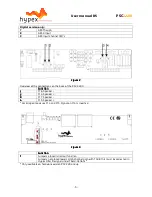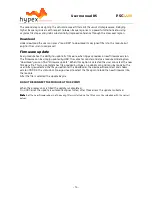
User manual R5
PSC
2
.
400
- 16 -
This symbol indicates the presence of hazardous voltages at accessible conductive terminals
on the board. Parts that are not highlighted in red (picture above) may carry voltages in ex-
cess of 140VDC!
1.
Read these instructions.
2.
Keep these instructions.
3.
Heed all warnings.
4.
Follow all instructions.
5.
Do not use this apparatus near water.
6.
Protect the power cord from being walked on or pinched particularly at plugs, convenience recep-
tacles, and the point where they exit from the application.
7.
Only use attachments/accessories specified or approved by the manufacturer.
8.
Unplug this apparatus during lightning storms or when unused for long periods of time.
9.
Refer all servicing to qualified service personnel. Servicing is required when the apparatus has
been damaged in any way, liquid has been spilled or objects have fallen into the apparatus, the ap-
paratus has been exposed to rain or moisture, does not operate normally or has been dropped.
10.
Don’t run any cables across the top or the bottom of the SMPS400. Apply fixtures to cables to
ensure that this is not compromised.
11.
Observe a minimum distance of 6mm maintain clearance with all possible conducting parts
(housing etc.). All parts enclosed by the dotted line below carry hazardous voltages. This includes
parts on the top and the bottom of the board.
12.
Natural convection should not be impeded by covering the SMPS400 (apart from the end applica-
tions housing).
Recommended Operating Conditions for the SMPS
Item
Symbol
Min
Typ
Max
Unit
Notes
High Line Input Voltage
V
B
180
230
264
Vac
Low Line Input Voltage
V
B,FP
90
115
132
Vac
Line Input Frequency
f
47
63
Hz
General Performance data for the SMPS
Item
Symbol
Min
Typ
Max
Unit
Notes
Max Output Power
P
R
600
-
-
W
See Note 1
Max Audio Output Power @ 20Hz
into amplifier load
P
RALF
400
-
-
W
See Note 2
Switching frequency
F
SW
80
100
120
kHz
Maximum power consumption
P
max
800
W
See Note 3
Note 1
Note 1
Note 1
Note 1: Output Power delivered to a resistive dummy load (generally the only specification supplied
by other SMPS manufacturers).
Note 2:
Note 2:
Note 2:
Note 2: An audio amplifier actually draws twice the RMS power from the power supply. At high fre-
quencies the secondary storage output caps are capable to provide this power. At very low frequen-
cies however the SMPS is responsible for delivering this peak power to the amplifier.
Note
Note
Note
Note 3
3
3
3:
:
:
: Limited by over current protection.




































